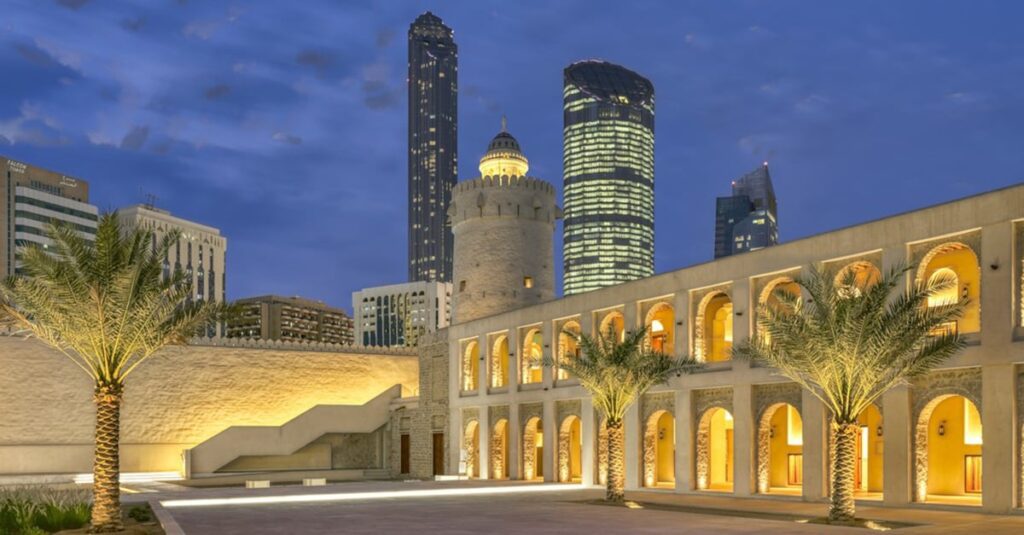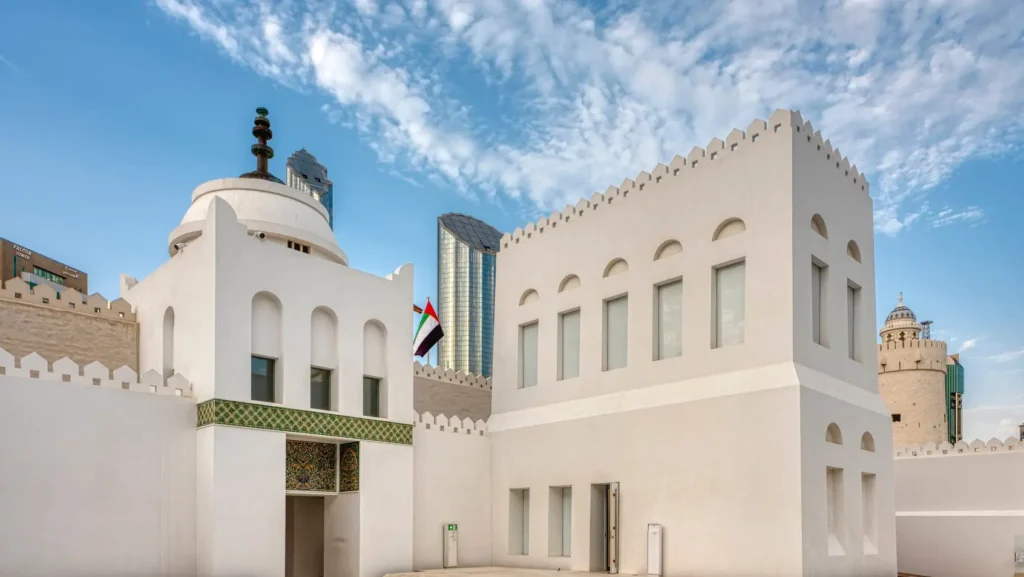Qasr Al Hosn stands as the oldest stone building in Abu Dhabi and one of the most treasured cultural landmarks in the United Arab Emirates. This historic fort is not just an architectural wonder but also a living memory of the UAE’s transformation from a small desert settlement into a modern nation. For centuries, Qasr Al Hosn has been at the heart of Abu Dhabi’s social, political, and cultural life, making it a timeless symbol of resilience, tradition, and identity.
Today, Qasr Al Hosn is more than a fort—it is a museum, cultural hub, and national treasure that continues to inspire Emiratis and visitors alike. To truly understand Abu Dhabi’s past and its journey toward modernity, one must walk through the walls of Qasr Al Hosn and witness its fascinating story.
The Origins of Qasr Al Hosn
The history of Qasr Al Hosn dates back to the late 18th century, when it was originally constructed as a watchtower to safeguard Abu Dhabi’s only freshwater well. Built in 1761, the watchtower provided protection for the settlement’s most vital resource—water. Over time, this modest structure expanded into a fort, eventually becoming the royal residence of the ruling Al Nahyan family and the seat of government.

Qasr Al Hosn not only protected the community but also symbolized authority and leadership. The fort’s thick walls, built from coral and sea stone, reflect the resourcefulness of early Emiratis, who used locally available materials to construct enduring structures.
Qasr Al Hosn as a Seat of Power
For nearly two centuries, Qasr Al Hosn served as the political and cultural heart of Abu Dhabi. It was the residence of the ruling family, a center of decision-making, and a hub for hosting guests and tribal leaders. Within its walls, major agreements were made that shaped the destiny of Abu Dhabi and, later, the entire nation.

The fort became a witness to the challenges and triumphs of Abu Dhabi’s rulers as they navigated the shifting tides of regional politics, tribal alliances, and the early oil discoveries that would transform the emirate’s future.
The Architecture of Qasr Al Hosn
Qasr Al Hosn’s architecture is a reflection of traditional Emirati building techniques and cultural values. The fort consists of two main sections:
- The Inner Fort (1795): Built around the original watchtower, it became the residence of the ruling family.
- The Outer Palace (1930s): A larger structure added to accommodate the growing needs of the royal household and administration.
The walls of Qasr Al Hosn are made from coral stones and sea rocks bonded with lime, while the ceilings use palm tree fronds and mangrove beams. This traditional approach to construction not only provided strength but also ensured natural ventilation, making the fort suitable for the desert climate.
Decorative features, including wooden doors, geometric carvings, and latticed windows, highlight the artistry of Emirati craftsmanship.

Transformation into a Cultural Landmark
By the late 20th century, as Abu Dhabi rapidly modernized, the significance of Qasr Al Hosn shifted from being a center of governance to becoming a symbol of heritage. In the 1990s, efforts began to restore and preserve the fort. The goal was not only to protect the structure but also to ensure that future generations could connect with their past.
In 2018, after a decade-long conservation project, Qasr Al Hosn reopened as a museum. The restoration carefully balanced modern preservation techniques with respect for traditional craftsmanship, ensuring that the fort retained its authenticity. Today, it stands as a cultural beacon, showcasing centuries of Emirati history.
What Visitors Experience at Qasr Al Hosn
Visiting Qasr Al Hosn offers a journey through time. The fort has been transformed into a museum that narrates the story of Abu Dhabi’s rise, from a humble settlement dependent on fishing and pearling to a thriving global capital.
Highlights of the Qasr Al Hosn Experience:
- Permanent Exhibitions – Visitors can explore galleries that display artifacts, manuscripts, photographs, and oral histories that trace the UAE’s cultural and political evolution.
- The House of Artisans – Adjacent to the fort, this center celebrates traditional Emirati crafts such as weaving (sadu), palm frond braiding (safeefa), and embroidery (talli). It is a living tribute to the artistry that shaped Emirati identity.
- Cultural Programs – Qasr Al Hosn regularly hosts events, workshops, and performances that highlight Emirati traditions, including falconry, music, and poetry.
- The Qasr Al Hosn Festival – An annual celebration that brings together art, culture, and history through live performances, reenactments, and interactive activities. It attracts thousands of visitors each year and reinforces the fort’s role as a living cultural hub.
The Role of Qasr Al Hosn in Preserving Heritage
In a country where modern skyscrapers dominate the skyline, Qasr Al Hosn serves as a reminder of Abu Dhabi’s roots. It bridges the past and present, offering both locals and visitors a space to learn, reflect, and celebrate Emirati culture.
The fort is not merely a preserved building—it is a storytelling space. Oral histories, traditional crafts, and interactive experiences ensure that heritage is passed down not only as history but as a living, breathing culture.
Qasr Al Hosn and the Story of Abu Dhabi’s Transformation
To understand the significance of Qasr Al Hosn, one must look at Abu Dhabi’s journey. Less than a century ago, the region depended heavily on pearl diving, fishing, and trade. The discovery of oil in the mid-20th century brought rapid economic transformation.
While the city embraced modernity, landmarks like Qasr Al Hosn anchored its people to their traditions. It became a symbol of continuity—a reminder that while Abu Dhabi reached new heights, its identity remained rooted in history.
Why Qasr Al Hosn Matters Today
In a fast-changing world, cultural landmarks like Qasr Al Hosn hold immense importance. They provide:
- A Sense of Identity: For Emiratis, the fort reinforces cultural pride and a deep sense of belonging.
- Education: Visitors learn about traditional lifestyles, architecture, and governance.
- Tourism: Qasr Al Hosn attracts tourists from around the globe, contributing to cultural tourism in Abu Dhabi.
- Community Engagement: The fort continues to serve as a gathering place for cultural festivals and events.

Planning a Visit to Qasr Al Hosn
Qasr Al Hosn is located in the heart of Abu Dhabi, making it easily accessible to residents and tourists alike. Visitors can explore the museum, attend cultural events, or simply admire the stunning architecture. Guided tours provide deeper insights into its history, while exhibitions offer hands-on experiences with traditional crafts.
Visitor Tips:
- Allocate at least two to three hours for a full experience.
- Check for ongoing exhibitions or the annual Qasr Al Hosn Festival.
- Explore the House of Artisans for interactive cultural workshops.
Conclusion: Qasr Al Hosn as a Living Treasure
Qasr Al Hosn is more than Abu Dhabi’s oldest stone building—it is the heart of Emirati history, culture, and resilience. From its beginnings as a watchtower guarding a freshwater well to its role as a royal residence and now as a cultural museum, the fort’s story mirrors the evolution of the UAE itself.
As a living treasure, Qasr Al Hosn continues to inspire future generations, reminding them that while Abu Dhabi looks toward the future with ambition, its roots remain deeply anchored in tradition.
For anyone seeking to understand the spirit of Abu Dhabi and the UAE, a visit to Qasr Al Hosn is not just recommended—it is essential.
Do follow UAE Stories on Instagram
Read More: Love Lake Dubai: A Romantic Desert Escape














